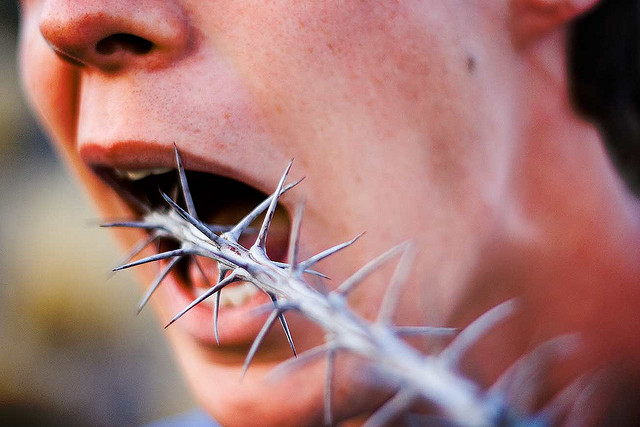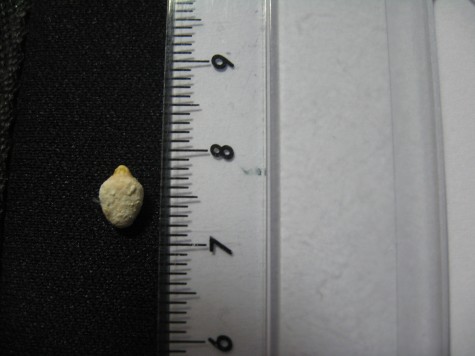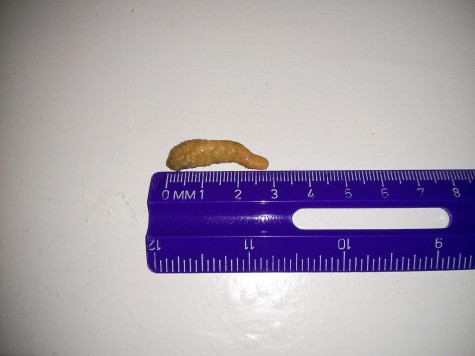This post originally ran on June 11, 2014. But the tale of one woman’s battle against the dreaded sialolith is so horrifying you’ll no doubt want to read it again.
 María Juan’s pain began eight years ago, at lunchtime. She was dining with her parents when suddenly she felt a sharp jab under her tongue. “Like an aguja,” she says — a needle. Each time she tried to swallow, she felt another poke. After the meal ended, the pain subsided. At dinner, however, it returned. And now the right side of her neck was a swollen. A couple of days later, María decided to see a doctor.
María Juan’s pain began eight years ago, at lunchtime. She was dining with her parents when suddenly she felt a sharp jab under her tongue. “Like an aguja,” she says — a needle. Each time she tried to swallow, she felt another poke. After the meal ended, the pain subsided. At dinner, however, it returned. And now the right side of her neck was a swollen. A couple of days later, María decided to see a doctor.
The doctor stuck one finger in her mouth and placed another finger on her neck, probing. He could feel something in her salivary gland. Something hard and strange. Something that wasn’t supposed to be there. He tried to pinch it out with his fingers, but it wouldn’t budge. There was nothing to do but wait. María left with some pills to make her salivate, and orders to drink lemon juice — a surefire way to produce spit. Amazingly, the regimen worked. The pain disappeared.
María’s official diagnosis was sialolithiasis, a fancy word for the formation of stones in the salivary gland. María’s stone had worked its way into her salivary duct, and now it was wedged. These stones, called sialoliths, aren’t as nearly as common as those that form in the kidney or gallbladder, but they do occur. And no one knows exactly why. Dehydration has been blamed, as well as certain medications; the pH of the saliva may also play a role. How they form is something of a mystery too. Some suspect that these calcified pebbles grow around mucus, free-floating cells, or even bacteria. Sometimes the stones form around debris that has worked its way into the salivary gland. A paper in the rather obscure journal of Oral Surgery, Oral Medicine, Oral Pathology, Oral Radiology, and Endodontology describes a 66-year-old man whose small sialolith contained a facial hair. Doctors have unearthed other foreign bodies too: a shrimp limb, a fish bone, a thorn.
María could only speculate about the cause of her sialolith, but its existence was beyond question. Three years later, the pain was back. For four days, María held out, hoping the ache would pass. By the fifth day, however, she could hardly move her tongue. A trip to the emergency room earned her some antibiotics and a bottle of painkillers. She spent the next two days in agony, her tongue too swollen to talk, waiting for the stone to pass. “I don’t have kids,” Maria says. But “when the stone is stuck there, you start to feel sometimes like a contraction. Something that is too big is trying to go through something small.” The pain was so intense María went back to the emergency room for stronger painkillers. That’s when the doctors discovered that Maria had not one, but two stones.
 A few days later, María woke up to find she wasn’t dizzy with pain. She went to the mirror and lifted her tongue. Underneath she could see a pebble just showing through the thin tissue on the floor of her mouth. And later that day, as she bit into a piece of chocolate, the stone popped out. It was about the size of a corn kernel, and remarkably similar in color and shape.
A few days later, María woke up to find she wasn’t dizzy with pain. She went to the mirror and lifted her tongue. Underneath she could see a pebble just showing through the thin tissue on the floor of her mouth. And later that day, as she bit into a piece of chocolate, the stone popped out. It was about the size of a corn kernel, and remarkably similar in color and shape.
Sialoliths are typically small, like María’s. But occasionally physicians run across monsters (sometimes referred to as megaliths): One paper describes a seven-centimeter stone the size of a “hen’s egg.” The big ones, of course, must be surgically removed, something I learned when I stumbled across a horrifying, yet mesmerizing video of a sialolith excision. (That video led me to another, and then another, and . . . well, let’s just say the rabbit hole of sialolith surgeries is bottomless. I’ll save you some time and just point you to the best one.) For smaller stones, however, doctors like to avoid the scalpel. While surgery might save some pain and suffering, the salivary glands are really close to some facial nerves that you definitely don’t want to cut.*
María’s second stone didn’t begin to cause real problems until a couple of weeks ago. And once again her doctor took a conservative “wait and see” approach. This time María knew what to expect. She stocked up on soups and straws. Her husband even bought a pack of Ensure to keep her energy up. “I had to be strong to fight with this stone,” she says. Five days later, María was bedridden, her tongue was so swollen she had to communicate with her husband via handwritten  notes. It was a no man’s land she thought she might never escape. “In Spanish we say, ‘ni para adelante, ni para atras,’” she says. But after one particularly bad night, she opened her eyes to find that the pain had diminished. By the evening, she could feel something scratching inside of her mouth. She checked the bathroom mirror, and lifted her tongue to get a better look. Each time she moved her tongue, the stone appeared, “like an iceberg,” she says.
notes. It was a no man’s land she thought she might never escape. “In Spanish we say, ‘ni para adelante, ni para atras,’” she says. But after one particularly bad night, she opened her eyes to find that the pain had diminished. By the evening, she could feel something scratching inside of her mouth. She checked the bathroom mirror, and lifted her tongue to get a better look. Each time she moved her tongue, the stone appeared, “like an iceberg,” she says.
María yelled for her husband, who came running. And in that moment, she managed to grasp the stone with her fingers and pull it free. The second stone was even bigger than the first. The event felt momentous, almost like a birth. “Jimmy and I were holding each other,” she says. And being rid of both stones left her “super happy, super happy, super happy, super happy.”
—
*Suffering from a sialolith and don’t want to suffer? Researchers are developing all kinds of new-fangled tools to remove them. See this review.
Image credits: Top via Eddie on Flickr. And the two photos in the body of the post are courtesy of María Juan.